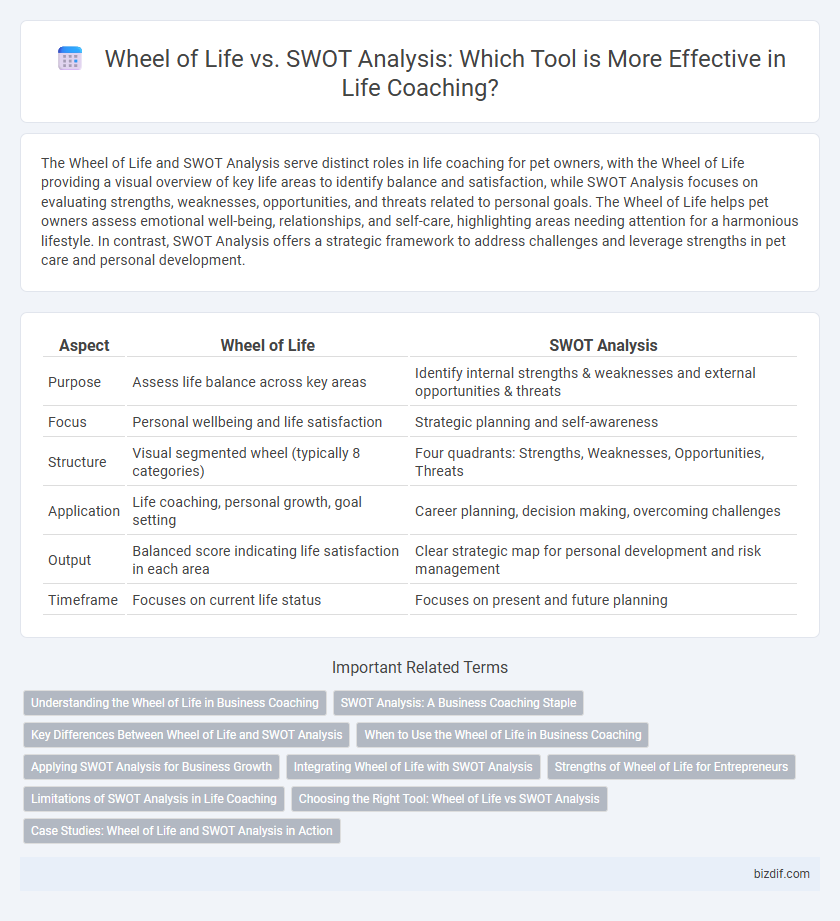The Wheel of Life and SWOT Analysis serve distinct roles in life coaching for pet owners, with the Wheel of Life providing a visual overview of key life areas to identify balance and satisfaction, while SWOT Analysis focuses on evaluating strengths, weaknesses, opportunities, and threats related to personal goals. The Wheel of Life helps pet owners assess emotional well-being, relationships, and self-care, highlighting areas needing attention for a harmonious lifestyle. In contrast, SWOT Analysis offers a strategic framework to address challenges and leverage strengths in pet care and personal development.
Table of Comparison
| Aspect | Wheel of Life | SWOT Analysis |
|---|---|---|
| Purpose | Assess life balance across key areas | Identify internal strengths & weaknesses and external opportunities & threats |
| Focus | Personal wellbeing and life satisfaction | Strategic planning and self-awareness |
| Structure | Visual segmented wheel (typically 8 categories) | Four quadrants: Strengths, Weaknesses, Opportunities, Threats |
| Application | Life coaching, personal growth, goal setting | Career planning, decision making, overcoming challenges |
| Output | Balanced score indicating life satisfaction in each area | Clear strategic map for personal development and risk management |
| Timeframe | Focuses on current life status | Focuses on present and future planning |
Understanding the Wheel of Life in Business Coaching
The Wheel of Life in business coaching provides a visual tool to assess balance across key areas such as career, finances, and personal growth, enhancing self-awareness and goal-setting. Unlike SWOT analysis, which evaluates strengths, weaknesses, opportunities, and threats primarily for strategic planning, the Wheel of Life emphasizes holistic life satisfaction and alignment. This approach fosters continuous improvement by highlighting areas needing attention to achieve overall harmony in both professional and personal domains.
SWOT Analysis: A Business Coaching Staple
SWOT Analysis remains a fundamental tool in business coaching, providing a structured framework to evaluate Strengths, Weaknesses, Opportunities, and Threats. It enables clients to gain critical insights into their strategic position, facilitating informed decision-making and goal setting. Compared to the Wheel of Life, SWOT Analysis offers a more comprehensive approach for identifying actionable business growth strategies and addressing challenges.
Key Differences Between Wheel of Life and SWOT Analysis
The Wheel of Life centers on assessing personal satisfaction across various life areas such as career, health, and relationships, providing a holistic overview of individual balance. SWOT Analysis evaluates internal strengths and weaknesses alongside external opportunities and threats, primarily used for strategic decision-making in business or personal development planning. Unlike SWOT's external focus and strategic framework, the Wheel of Life emphasizes emotional well-being and life balance through visual self-assessment tools.
When to Use the Wheel of Life in Business Coaching
Use the Wheel of Life in business coaching to assess clients' overall life balance across key areas such as career, finances, health, and personal development. This tool helps identify imbalances that impact professional performance and guides goal-setting for holistic growth. It complements SWOT analysis by focusing on personal fulfillment rather than solely organizational strengths, weaknesses, opportunities, and threats.
Applying SWOT Analysis for Business Growth
Applying SWOT analysis in life coaching enables business growth by identifying strengths, weaknesses, opportunities, and threats specific to the client's personal and professional life. Unlike the Wheel of Life, which provides a holistic balance assessment, SWOT analysis offers actionable insights to strategically address challenges and leverage growth potential. This targeted approach helps clients develop focused business plans, optimize resources, and enhance decision-making for sustained success.
Integrating Wheel of Life with SWOT Analysis
Integrating the Wheel of Life with SWOT Analysis creates a comprehensive life coaching tool that assesses both personal satisfaction and internal strengths, weaknesses, opportunities, and threats. This combined approach enables clients to identify areas needing improvement while leveraging their capabilities and external possibilities. Life coaches enhance goal-setting strategies by aligning emotional well-being with strategic planning through this fusion.
Strengths of Wheel of Life for Entrepreneurs
The Wheel of Life provides entrepreneurs with a holistic framework to evaluate and balance key life areas such as career, relationships, and personal growth, promoting overall well-being and sustained productivity. Unlike SWOT Analysis, which focuses primarily on business factors like strengths, weaknesses, opportunities, and threats, the Wheel of Life emphasizes personal fulfillment and alignment, which are critical for long-term entrepreneurial success. This approach helps entrepreneurs identify imbalances and prioritize self-care, ultimately enhancing decision-making and resilience.
Limitations of SWOT Analysis in Life Coaching
SWOT Analysis in life coaching often falls short due to its static nature, which limits ongoing personal growth assessment and overlooks emotional and psychological factors essential for holistic development. Unlike the dynamic Wheel of Life that visually balances multiple life areas, SWOT tends to isolate strengths, weaknesses, opportunities, and threats without integrating them into a comprehensive well-being framework. This reductionist approach can result in missed insights about clients' intricate life satisfaction dimensions and evolving priorities.
Choosing the Right Tool: Wheel of Life vs SWOT Analysis
Choosing the right tool depends on the specific life coaching goal: the Wheel of Life provides a visual snapshot of balance across key life areas such as health, career, and relationships, ideal for identifying areas needing improvement. In contrast, SWOT Analysis offers a strategic framework to assess personal Strengths, Weaknesses, Opportunities, and Threats, useful for decision-making and goal setting. Life coaches often integrate both tools to achieve a comprehensive understanding of clients' current status and future potential.
Case Studies: Wheel of Life and SWOT Analysis in Action
Case studies examining the Wheel of Life and SWOT Analysis reveal distinct applications in life coaching, where the Wheel of Life offers a balanced self-assessment across personal domains and SWOT Analysis identifies internal strengths and external opportunities for growth. Clients using the Wheel of Life demonstrate increased self-awareness and targeted goal-setting, while those applying SWOT Analysis develop strategic plans to overcome challenges and leverage resources. Integrating both tools in coaching sessions enhances clarity and actionable insights, facilitating comprehensive personal development.
Wheel of Life vs SWOT Analysis Infographic

 bizdif.com
bizdif.com